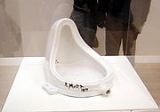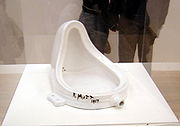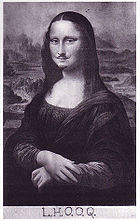
Readymades of Marcel Duchamp
Encyclopedia

Marcel Duchamp
Marcel Duchamp was a French artist whose work is most often associated with the Dadaist and Surrealist movements. Considered by some to be one of the most important artists of the 20th century, Duchamp's output influenced the development of post-World War I Western art...
are ordinary manufactured objects that the artist selected and modified, as an antidote to what he called "retinal art". By simply choosing the object (or objects) and repositioning or joining, titling and signing it, the object became art. As the process involved the least amount of interaction between artist and art, it represented the most extreme form of minimalism up to that time.
Duchamp was not interested in what he called "retinal art" — art that was only visual — and sought other methods of expression. As an antidote to "retinal art" he began creating readymades at a time (1915) when the term was commonly used in the US to describe manufactured items to distinguish them from handmade goods.
He selected the pieces on the basis of "visual indifference," and the selections reflect his sense of irony, humor and ambiguity. "...it was always the idea that came first, not the visual example," he said; "...a form of denying the possibility of defining art."
The only definition of "readymade" published under the name of Marcel Duchamp (or his initials, "MD," to be precise) exists in André Breton
André Breton
André Breton was a French writer and poet. He is known best as the founder of Surrealism. His writings include the first Surrealist Manifesto of 1924, in which he defined surrealism as "pure psychic automatism"....
and Paul Éluard
Paul Éluard
Paul Éluard, born Eugène Émile Paul Grindel , was a French poet who was one of the founders of the surrealist movement.-Biography:...
's Dictionnaire abrégé du Surréalisme: "an ordinary object elevated to the dignity of a work of art by the mere choice of an artist." However, André Gervais asserts that Breton wrote this definition for the Surrealist dictionary.
Duchamp limited his yearly output of readymades, making no more than 20 in his lifetime. He felt that only by limiting output, could he avoid the trap of his own taste. Though he was aware of the contradiction of avoiding taste, yet also selecting an object. Taste, "good" or "bad," he felt was the "enemy of art."
Through the years his own concept of the readymades kept changing. "My intention was to get away from myself, though I knew perfectly well that I was using myself. Call it a little game between 'I' and 'me'."
Duchamp was unable to define or explain his opinion of readymades: "The curious thing about the readymade is that I've never been able to arrive at a definition or explanation that fully satisfies me." Much later in life Duchamp said, "I'm not at all sure that the concept of the readymade isn't the most important single idea to come out of my work."
The objects themselves
By submitting some of them as art to art juries, the public, and his patrons, Duchamp challenged conventional notions of what is, and what is not, art. Some were rejected by art juries and others went unnoticed at art shows.Most of his early readymades have been lost or discarded, but years later he commissioned reproductions of many of them.
Types of readymades
- Readymades - un-altered objects
- Assisted readymades
- Rectified readymades
- Corrected readymades
- Reciprocal readymades - using Rembrandt as an ironing board.
Readymades
(Note: Some art historians consider only the un-altered manufactured objects to be readymades. This list includes the pieces he altered or constructed.)Bottle Rack
Bottle Rack
The Bottle Rack is an artwork created in 1914 by Dada artist Marcel Duchamp. Duchamp labeled the piece a "readymade", a term he used to describe his collection of ordinary, manufactured objects not commonly associated with art...
(also called Bottle Dryer or Hedgehog) (Egouttoir or Porte-bouteilles or Hérisson), 1914. Philadelphia Museum of Art
- A galvanized iron bottle drying rack that Duchamp bought in 1914 as an "already made" sculpture, but it gathered dust in the corner of his Paris studio because the idea of "readymade" had not yet been born. Two years later, through correspondence from New York with his sister, Suzanne DuchampSuzanne DuchampSuzanne Duchamp-Crotti was a French Dadaist painter. Born in Blainville-Crevon, Seine-Maritime in the Haute-Normandie Region of France, she was the fourth of six children born into the artistic family of Eugene and Lucie Duchamp.Suzanne Duchamp-Crotti was the younger sister of:*Jacques Villon née...
, in France he intended to make it a readymade by asking her to paint on it "(from) Marcel Duchamp." However, Suzanne, who was looking after his Paris studio, had already disposed of it.
In advance of the broken arm (En prévision du bras cassé), 1915. External link
- Snow shovel on which he carefully painted its title. The first piece the artist called a "readymade." New to America, Duchamp had never seen a snow shovel not manufactured in France. With fellow Frenchman Jean CrottiJean CrottiJean Crotti was a French painter.Crotti was born in Bulle, Fribourg, Switzerland. He first studied in Munich, Germany at the School of Decorative Arts, then at age 23 moved to Paris to study art at the Académie Julian. Initially he was influenced by Impressionism, then by Fauvism and Art Nouveau...
he purchased it from a stack of them, took it to their shared studio, painted the title and "from Marcel Duchamp 1915" on it, and hung it from a wire in the studio. Many years later, a replica of the piece is said to have been mistaken for an ordinary snow shovel and used to move snow off the sidewalks of Chicago.
Pulled at 4 pins, 1915. External link
- An unpainted chimney ventilator that turns in the wind. The title is a literal translation of the French phrase, "tiré à quatre épingles," roughly equivalent to the English phrase "dressed to the nines." Duchamp liked that the literal translation meant nothing in English and had no relation to the object.
Comb (Peigne), 1916. Philadelphia Museum of Art
- Steel dog grooming comb inscribed along the edge in white, "3 ou 4 gouttes de hauteur n'ont rien a faire avec la sauvagerie; M.D. Feb. 17 1916 11 a.m." ("Three or Four Drops of Height [or Haughtiness] Have Nothing to Do with Savagery.")
Traveller's Folding Item (...pliant,... de voyage), 1916. External link
- Underwood Typewriter cover.

Fountain (Duchamp)
Fountain is a 1917 work by Marcel Duchamp. It is one of the pieces which he called readymades. In such pieces he made use of an already existing object. In this case Duchamp used a urinal, which he titled Fountain and signed "R. Mutt". Readymades also go by the term Found object...
, 1917.
- Porcelain urinal inscribed "R. Mutt 1917." The board of the 1917 the Society of Independent ArtistsSociety of Independent ArtistsSociety of Independent Artists was an association of American artists founded in 1916 and based in New York.Based on the French Société des Artistes Indépendants, the goal of the society was to hold annual exhibitions by avant-garde artists. Exhibitions were to be open to anyone who wanted to...
exhibit, of which Duchamp was a director, after much debate about whether Fountain was or was not art, hid the piece from view during the show. Duchamp quickly quit the society, and the publication of Blind Man, which followed the exhibition was devoted to the controversy.
Trap (Trébuchet), 1917. External link
- Wood and metal coatrack. Duchamp submitted it to a show at the Bourgeois Art Gallery and asked that it be placed near the entryway. It went unnoticed as art during the show.
50 cc of Paris Air (50 cc air de Paris, Paris Air or Air de Paris) (1919) Philadelphia Museum of Art (1919) Philadelphia Museum of Art (1949)
- A glass ampoule containing air from ParisParisParis is the capital and largest city in France, situated on the river Seine, in northern France, at the heart of the Île-de-France region...
. Duchamp took the ampoule to New YorkNew YorkNew York is a state in the Northeastern region of the United States. It is the nation's third most populous state. New York is bordered by New Jersey and Pennsylvania to the south, and by Connecticut, Massachusetts and Vermont to the east...
in 1920 and gave it to Walter ArensbergWalter ArensbergWalter Conrad Arensberg was an American art collector, critic and poet. His father was part owner and president of a crucible steel company. He majored in English and philosophy at Harvard University...
as a gift. The original was broken and replaced in 1949 by Duchamp. (Contrary to its title, the volumeVolumeVolume is the quantity of three-dimensional space enclosed by some closed boundary, for example, the space that a substance or shape occupies or contains....
of air inside the ampoule was not actually 50 cubic centimeters, although when replicas were made in later decades, 50 cc of air was used. The original ampoule is thought to have contained around 125 cc of air.)
Fresh Widow, 1920.
The Brawl at Austerlitz, 1921. External link
Assisted readymades
Bicycle WheelBicycle Wheel
Bicycle Wheel is a readymade by Marcel Duchamp consisting of a bicycle fork with front wheel mounted upside-down on a wooden stool.In 1913 at his Paris studio he mounted the bicycle wheel upside down onto a stool, spinning it occasionally just to watch it. Later he denied that its creation was...
(Roue de bicyclette), 1913.Museum of Modern Art
- Bicycle wheel mounted by its fork on a painted wooden stool. He fashioned it to amuse himself by spinning it, "...like watching a fire... It was a pleasant gadget, pleasant for the movement it gave." The first readymade, though he initiated the ideas two years later. The original from 1913 was lost, and Duchamp recreated the sculpture in 1951.
- Bicycle Wheel is also said to be the first kinetic sculpture.
With Hidden Noise (A bruit secret), 1916. Philadelphia Museum of Art
- A ball of twine between two brass plates, joined by four screws. An unknown object has been placed in the ball of twine by one of Duchamp's friends.

Unhappy readymade, 1919. External link
- Duchamp instructed his sister SuzanneSuzanne DuchampSuzanne Duchamp-Crotti was a French Dadaist painter. Born in Blainville-Crevon, Seine-Maritime in the Haute-Normandie Region of France, she was the fourth of six children born into the artistic family of Eugene and Lucie Duchamp.Suzanne Duchamp-Crotti was the younger sister of:*Jacques Villon née...
to hang a geometry textbook from the balcony of her Paris apartment so that the problems and theorems, exposed to the test of the wind, sun and rain, could "get the facts of life." Suzanne carried out the instructions and painted a picture of the result.
Belle Haleine, Eau de Violette, 1921. External link
- A perfume bottle in the original box.

- Marble cubes in the shape of sugar lumps with a thermometer and cuttle bones in a small bird cage.
Rectified readymades
Pharmacy (Pharmacie), 1914External link- Gouache on chromolithograph of a scene with bare trees and a winding stream to which he added two dots of watercolor, red and green, like the colored liquids in a pharmacy.
Apolinère Enameled
Apolinère Enameled
"Apolinère Enameled" was painted circa 1916 by Marcel Duchamp, as an advertisement for paint. The picture depicts a girl painting a bed-frame with white enamelled paint. The depiction of the frame deliberately includes conflicting perspective lines, to produce an impossible object. To emphasise the...
, 1916-1917. Philadelphia Museum of Art
- A Sapolin paint advertisement.
L.H.O.O.Q.
L.H.O.O.Q.
L.H.O.O.Q. is a work of art by Marcel Duchamp first conceived in 1919. The work is one of what Duchamp referred to as readymades, or more specifically an assisted ready-made...
, 1919.
- Pencil on a reproduction of Leonardo da Vinci's Mona LisaMona LisaMona Lisa is a portrait by the Italian artist Leonardo da Vinci. It is a painting in oil on a poplar panel, completed circa 1503–1519...
on which he drew a goateeGoateeGoatee refers to a style of facial hair incorporating hair on a man’s chin. The exact nature of the style has varied according to time and culture.Traditionally, goatee refers solely to a beard formed by a tuft of hair on the chin...
and moustacheMoustacheA moustache is facial hair grown on the outer surface of the upper lip. It may or may not be accompanied by a type of beard, a facial hair style grown and cropped to cover most of the lower half of the face.-Etymology:...
. The name when pronounced in French is a coarse French pun — "elle a chaud au cul" translating colloquially as "she's got a hot ass" or "her ass is on fire".
Wanted, $2,000 Reward, 1923. External link
- Photographic collage on poster.
Doubts over readymades
Research published in 1997 by Rhonda Roland ShearerRhonda Roland Shearer
Rhonda Roland Shearer is an American sculptor, scholar and journalist, who founded the nonprofit organization Art Science Research Laboratory with her late husband Stephen Jay Gould. The mission statement avows that the lab aims to "infuse intellectual rigor and critical thinking in disciplines...
questions whether Duchamp's "found" objects may actually have been created by Duchamp. Her research of items like snow shovels and bottle racks in use at the time failed to turn up any identical matches to photographs of the originals. However, there are accounts of Walter Arensberg
Walter Arensberg
Walter Conrad Arensberg was an American art collector, critic and poet. His father was part owner and president of a crucible steel company. He majored in English and philosophy at Harvard University...
and Joseph Stella
Joseph Stella
Joseph Stella was an Italian-born, American Futurist painter best known for his depictions of industrial America. He is associated with the American Precisionism movement of the 1910s-1940s....
being with Duchamp when he purchased the original Fountain at J. L. Mott Iron Works. Such investigations are hampered by the fact that few of the original "readymades" survive, having been lost or destroyed. Those that still exist are predominantly reproductions authorized or designed by Duchamp in the final two decades of his life. Shearer also asserts that the artwork L.H.O.O.Q. which is recorded to be a poster-copy of the Mona Lisa
Mona Lisa
Mona Lisa is a portrait by the Italian artist Leonardo da Vinci. It is a painting in oil on a poplar panel, completed circa 1503–1519...
with a moustache drawn on it, is not the true Mona Lisa, but Duchamp's own slightly-different version that he modelled partly after himself. The inference of Shearer's viewpoint is that Duchamp was creating an even larger joke than he admitted.
 |

